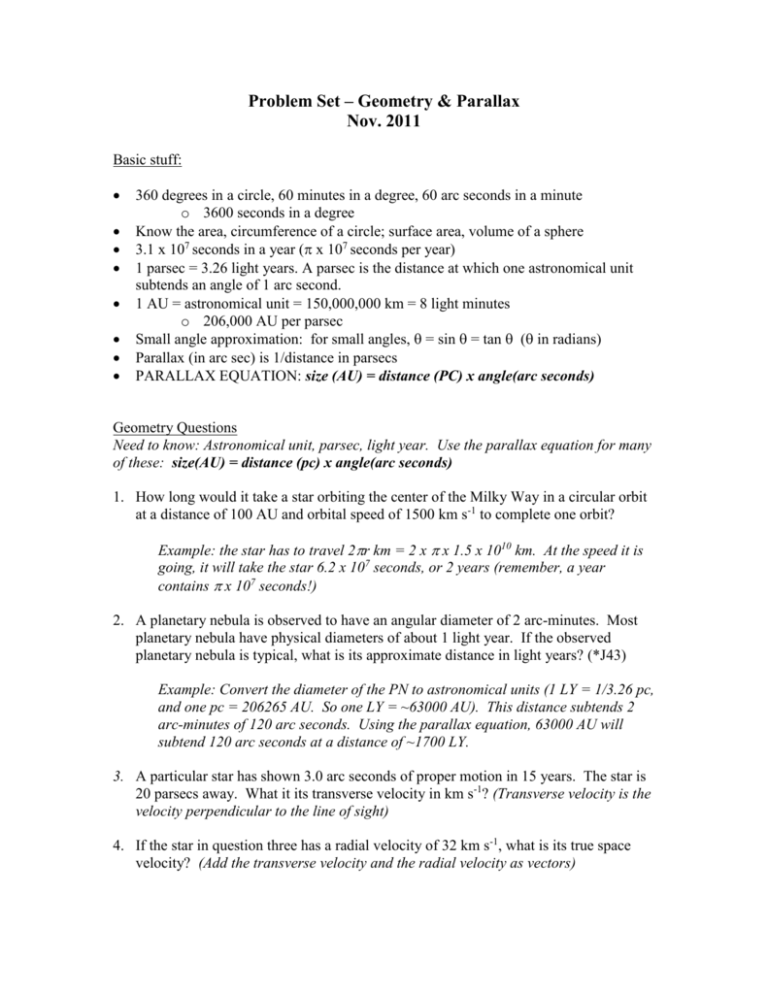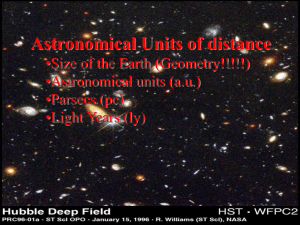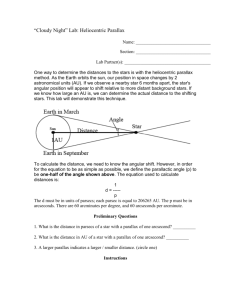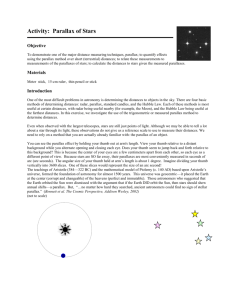Geometry and Parallax Problems
advertisement

Problem Set – Geometry & Parallax Nov. 2011 Basic stuff: 360 degrees in a circle, 60 minutes in a degree, 60 arc seconds in a minute o 3600 seconds in a degree Know the area, circumference of a circle; surface area, volume of a sphere 3.1 x 107 seconds in a year ( x 107 seconds per year) 1 parsec = 3.26 light years. A parsec is the distance at which one astronomical unit subtends an angle of 1 arc second. 1 AU = astronomical unit = 150,000,000 km = 8 light minutes o 206,000 AU per parsec Small angle approximation: for small angles, = sin = tan ( in radians) Parallax (in arc sec) is 1/distance in parsecs PARALLAX EQUATION: size (AU) = distance (PC) x angle(arc seconds) Geometry Questions Need to know: Astronomical unit, parsec, light year. Use the parallax equation for many of these: size(AU) = distance (pc) x angle(arc seconds) 1. How long would it take a star orbiting the center of the Milky Way in a circular orbit at a distance of 100 AU and orbital speed of 1500 km s-1 to complete one orbit? Example: the star has to travel 2r km = 2 x x 1.5 x 1010 km. At the speed it is going, it will take the star 6.2 x 107 seconds, or 2 years (remember, a year contains x 107 seconds!) 2. A planetary nebula is observed to have an angular diameter of 2 arc-minutes. Most planetary nebula have physical diameters of about 1 light year. If the observed planetary nebula is typical, what is its approximate distance in light years? (*J43) Example: Convert the diameter of the PN to astronomical units (1 LY = 1/3.26 pc, and one pc = 206265 AU. So one LY = ~63000 AU). This distance subtends 2 arc-minutes of 120 arc seconds. Using the parallax equation, 63000 AU will subtend 120 arc seconds at a distance of ~1700 LY. 3. A particular star has shown 3.0 arc seconds of proper motion in 15 years. The star is 20 parsecs away. What it its transverse velocity in km s-1? (Transverse velocity is the velocity perpendicular to the line of sight) 4. If the star in question three has a radial velocity of 32 km s-1, what is its true space velocity? (Add the transverse velocity and the radial velocity as vectors) 5. An expanding spherical shell of gas has been expanding for 24,000 years. The radius of the object is now 2.5 light years. What is the speed in km s-1 of the leading edge of the ring? 6. What is the angular diameter in arc seconds of the object in question 5? The object is at a distance of 7,000 light years. 7. The spherical shell in question 5 has an angular thickness of 10.1". The density in the shell is 4.94E-20 g m-3. What is the mass of the shell in solar masses? (*L29) 8. A planetary nebula in the constellation Lyra is 2700 light years from Earth. It has an angular diameter of 1.4 arc minutes and is expanding at a rate of about 20 km s-1. How long ago did the central star shed its layers? (Mc31) 9. What is the average rate of expansion of an object at a distance of 3000 light years if the object is 1000 years old and is now 400 times larger than the Solar System? (Assume the Sun-Pluto distance is 39.5 AU). (Q63) 10. An expanding cloud has a diameter of 4 arc minutes. The distance to the object is 10,000 light years. The expansion began in 1680. What is the average expansion velocity of the leading edge of the expanding cloud? (R10) 11. A galaxy at a distance of 4 megaparsecs from Earth has two radio lobes that span about 1 megaparsec. What is the angular size of this galaxy? (R19) How does this compare with the angular diameter of the Moon (about ½ degree)? (R20) 12. A nearby galaxy is approaching the Milky Way at a velocity of 266 km s-1. It current distance is about 930 megaparsecs. How long will it be before the two galaxies collide? (R21) Parallax Questions Use the parallax equation for many of these: size(AU) = distance (pc) x angle(arc seconds) 1. A satellite in a circular orbit around the Earth observe the position of a star to change by 0.00000008 arc seconds. The distance to the star is 5000 parsecs. What is the radius of the satellite's orbit? (J42) 2. A star has a parallax of 0.033 arc seconds as measured from Earth. What is the distance to the star in parsecs? (J38) 3. An observer on Earth measure Star A to have a parallax of 0.002"; what is the distance to Star A in parsecs? (K37) 4. An observer on Mars measures Star B to have a parallax of 0.002"; what is the distance to Star B in parsecs? (K38) 5. An observer on Earth measures the position of Star C on June 3rd, 1985, and again 3 months later, and observers its position to have changed by 0.002". What is the distance to star C in parsecs? (K39) 6. The Hipparcos mission has catalogued thousands of stars' stellar parallax. One such star, HIP 9955, has a parallax of 9.43 milliarcseconds. How far away is it, in light years? (L15) 7. What is the parallax of a star with a distance of 20 parsecs? (L24) 8. An observer on Earth observes a nearby star to have an annual parallax of 0.10" but an observer on another planet in our Solar System observes the same star to have a parallax of 0.15". How far is this planet from the Sun? (the semi-major axis of the Earth's orbit is 1.5x108 km) (Mc1) Answer Key – Geometry & Parallax Questions Geometry Questions 1. 2 years (J9) 2. *1700 LY (850-870 LY J43) 3. 19.0 km/s (L19) 4. *37 km/s (57 km/s L20) 5. 31 km/s (~L28) 6. 147arc sec (~L27) 7. 0.6 solar masses (L29) 8. ~7000 years (Mc31) 9. *75 km/s (300 km/sec Q63) 10. ~5400 km/s (R10) 11. 14 degrees (R19) 28 times larger (R20) 12. 3.4 x 106 years (R21) Parallax Questions 1. 30,000 km (J42) 2. 30 pc (J38) 3. 500 pc (K37) 4. 760 pc (K38) 5. *250 pc – (354 pc K39) 6. 346 LY (L15) 7. 0.05 arc sec (L24) 8. 2.25 x 108 km (Mc1)









